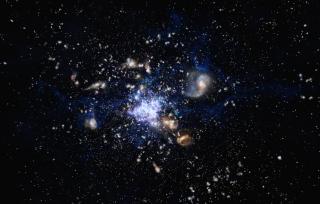Bibcode
Naufal, Abdurrahman; Koyama, Yusei; D'Eugenio, Chiara; Dannerbauer, Helmut; Shimakawa, Rhythm; Pérez-Martínez, Jose Manuel; Kodama, Tadayuki; Zhang, Yuheng; Daikuhara, Kazuki
Bibliographical reference
The Astrophysical Journal
Advertised on:
12
2024
Journal
Citations
7
Refereed citations
6
Description
We report the Hubble Space Telescope Wide Field Camera 3 G141 grism slitless spectroscopy observation of the core region of the Spiderweb protocluster at z = 2.16. We analyzed the spectra of all objects in a field of view and identified 40 protocluster members, recovering 19 previously identified Hα emitters in addition to revealing 21 new members. The spectra allowed us to identify 11 galaxies with quiescent spectra. In all, 3 galaxies with quiescent spectra are possibly still star forming according to spectral energy distribution fitting, indicating a possible leftover or dust-obscured star formation. We estimate a quiescent fraction of ∼50% for M ⋆ > 1011 M ⊙. About half of the quiescent galaxies possibly host an active galactic nucleus (AGN), hinting at AGN's key role in quenching galaxies in the protocluster environment. These quiescent galaxies have relatively more compact and concentrated light profiles than the star-forming members, but they are not yet as bulge dominated as local ellipticals. These results are consistent with previous studies that indicate the Spiderweb protocluster is in the maturing stage, with a red sequence that has begun forming.
Related projects

Molecular Gas and Dust in Galaxies Across Cosmic Time
Two of the most fundamental questions in astrophysics are the conversion of molecular gas into stars and how this physical process is a function of environments on all scales, ranging from planetary systems, stellar clusters, galaxies to galaxy clusters. The main goal of this internal project is to get insight into the formation and evolution of
Helmut
Dannerbauer